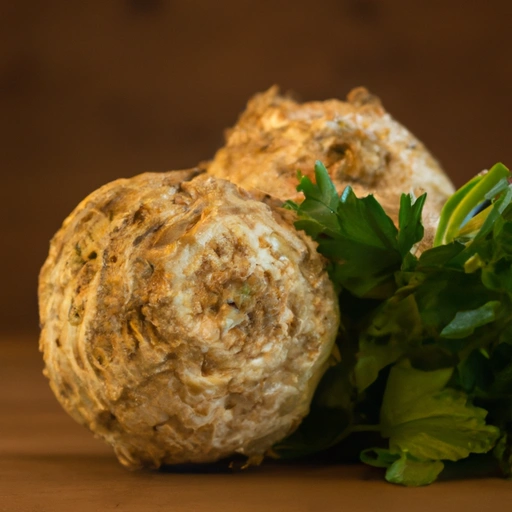Celeriac
Description

Celeriac, also known as celery root, is a variety of celery cultivated for its edible, bulbous root. It is a lesser-known root vegetable with a knobby surface and an ivory-white interior. Its unique flavor is reminiscent of a cross between celery stalks and parsley, with a subtle, earthy undertone.
Common uses
Celeriac is typically used as a flavor enhancer in soups, stews, and broths, but can also be consumed raw in salads, providing a crunchy texture and a fresh taste. Additionally, it is often mashed or pureed as a lower-carbohydrate alternative to potatoes.
Nutritional value
Calories
Celeriac is low in calories, with approximately 42 calories per 100 grams (3.5 oz).
Protein
It contains about 1.5 grams of protein per 100 grams (3.5 oz).
Fat
This root vegetable is virtually fat-free, having less than 0.3 grams of fat per 100 grams (3.5 oz).
Carbohydrates
Celeriac is composed of about 9.2 grams of carbohydrates per 100 grams (3.5 oz), making it a suitable option for low-carb diets.
Vitamins
It is a good source of Vitamin K, providing about 41 micrograms or approximately 34% of the Daily Value (DV) per 100 grams (3.5 oz).
Minerals
Celeriac is rich in minerals such as phosphorus, with 115 milligrams per 100 grams (3.5 oz), and potassium, containing 300 milligrams per 100 grams (3.5 oz).
Health benefits
The vegetable is known for its dietary fiber content, which supports digestive health, and its vitamin K, essential for bone health. The potassium content helps to maintain cardiovascular health by regulating blood pressure.
Potential risks
Those with a known allergy to celery should avoid celeriac as it can cause similar allergic reactions. It is also important to thoroughly wash and peel celeriac, as its rough exterior can harbor soil and bacteria.
Common recipes
Celeriac is featured in the classic French dish 'celeri remoulade', and is also used in roasted vegetable medleys, creamy purees, and hearty casseroles.
Cooking methods
It can be roasted, boiled, steamed, or sautéed. Due to its firm texture, it holds up well to long cooking times and can be substituted for other root vegetables in recipes.
Pairing with other ingredients
This versatile ingredient pairs well with apples, nuts, and strong cheeses in salads. In cooked dishes, it complements herbs like thyme and bay leaves, and proteins such as pork and poultry.
Summary
Celeriac is a nutritious and versatile root vegetable that offers a unique flavor profile and a host of health benefits. With its growing popularity in international cuisines, celeriac is an excellent addition to a variety of dishes, adding depth and nuance to both traditional and contemporary recipes.